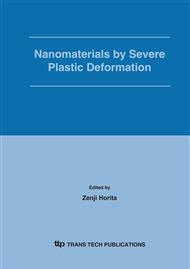p.907
p.913
p.919
p.925
p.931
p.937
p.943
p.949
p.955
Three Dimensional Numerical Investigation of Equal Channel Multi-Angular Pressing
Abstract:
Plastic deformation behavior during equal channel multi-angular pressing (ECMAP) was analyzed using the three dimensional finite volume method of the commercial code MSC.Superforge. In order to understand local and global deformation characteristics, effective strain and pressing load histories were investigated. The predicted plastic deformation behavior of the workpiece material during ECMAP of route A, route B and route C with a theoretical total strain of ~2.2 upon a single pass at three different friction factors (m=0, 0.1 and 0.2) was compared. The predicted strain results show different values in outside and similar values in central regions of the processed workpieces with different friction and forming routes. The pressing loads are higher under higher friction condition, showing almost no difference with three different pressing routes.
Info:
Periodical:
Pages:
931-936
Citation:
Online since:
January 2006
Authors:
Price:
Сopyright:
© 2006 Trans Tech Publications Ltd. All Rights Reserved
Share:
Citation:


